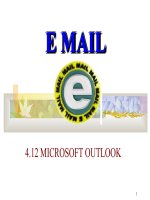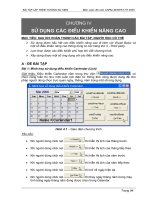Chuong 4 icmp
Bạn đang xem bản rút gọn của tài liệu. Xem và tải ngay bản đầy đủ của tài liệu tại đây (3 MB, 58 trang )
Chapter 9
Internet Control Message
Protocol
Objectives
Upon completion you will be able to:
• Be familiar with the ICMP message format
• Know the types of error reporting messages
• Know the types of query messages
• Be able to calculate the ICMP checksum
• Know how to use the ping and traceroute commands
• Understand the modules and interactions of an ICMP package
TCP/IP Protocol Suite
1
Figure 9.1
TCP/IP Protocol Suite
Position of ICMP in the network layer
2
Figure 9.2
TCP/IP Protocol Suite
ICMP encapsulation
3
9.1 TYPES OF MESSAGES
ICMP messages are divided into error-reporting messages and query
messages. The error-reporting messages report problems that a router or
a host (destination) may encounter. The query messages get specific
information from a router or another host.
TCP/IP Protocol Suite
4
Figure 9.3
TCP/IP Protocol Suite
ICMP messages
5
Table 9.1 ICMP messages
TCP/IP Protocol Suite
6
9.2 MESSAGE FORMAT
An ICMP message has an 8-byte header and a variable-size data section.
Although the general format of the header is different for each message
type, the first 4 bytes are common to all.
TCP/IP Protocol Suite
7
Figure 9.4
TCP/IP Protocol Suite
General format of ICMP messages
8
9.3 ERROR REPORTING
IP, as an unreliable protocol, is not concerned with error checking and
error control. ICMP was designed, in part, to compensate for this
shortcoming. ICMP does not correct errors, it simply reports them.
The topics discussed in this section include:
Destination Unreachable
Source Quench
Time Exceeded
Parameter Problem
Redirection
TCP/IP Protocol Suite
9
Note:
ICMP always reports error messages
to the original source.
TCP/IP Protocol Suite
10
Figure 9.5
TCP/IP Protocol Suite
Error-reporting messages
11
Note:
The following are important points about ICMP
error messages:
❏ No ICMP error message will be generated in response
to a datagram carrying an ICMP error message.
❏ No ICMP error message will be generated for a
fragmented datagram that is not the first fragment.
❏ No ICMP error message will be generated for a
datagram having a multicast address.
❏ No ICMP error message will be generated for a
datagram having a special address such as 127.0.0.0 or
0.0.0.0.
TCP/IP Protocol Suite
12
Figure 9.6
TCP/IP Protocol Suite
Contents of data field for the error messages
13
Figure 9.7
TCP/IP Protocol Suite
Destination-unreachable format
14
Note:
Destination-unreachable messages
with codes 2 or 3 can be created only
by the destination host.
Other destination-unreachable
messages can be created only by
routers.
TCP/IP Protocol Suite
15
Note:
A router cannot detect all problems
that prevent the delivery of a packet.
TCP/IP Protocol Suite
16
Note:
There is no flow-control mechanism in
the IP protocol.
TCP/IP Protocol Suite
17
Figure 9.8
TCP/IP Protocol Suite
Source-quench format
18
Note:
A source-quench message informs the
source that a datagram has been
discarded due to congestion in a router
or the destination host.
The source must slow down the
sending of datagrams until the
congestion is relieved.
TCP/IP Protocol Suite
19
Note:
One source-quench message is sent for
each datagram that is discarded due to
congestion.
TCP/IP Protocol Suite
20
Note:
Whenever a router decrements a
datagram with a time-to-live value to
zero, it discards the datagram and
sends a time-exceeded message to the
original source.
TCP/IP Protocol Suite
21
Note:
When the final destination does not
receive all of the fragments in a set
time, it discards the received fragments
and sends a time-exceeded message to
the original source.
TCP/IP Protocol Suite
22
Note:
In a time-exceeded message, code 0 is
used only by routers to show that the
value of the time-to-live field is zero.
Code 1 is used only by the destination
host to show that not all of the
fragments have arrived within a set
time.
TCP/IP Protocol Suite
23
Figure 9.9
TCP/IP Protocol Suite
Time-exceeded message format
24
Note:
A parameter-problem message can be
created by a router or the destination
host.
TCP/IP Protocol Suite
25









